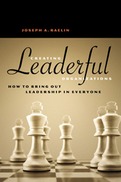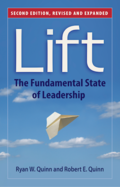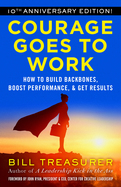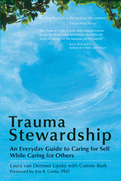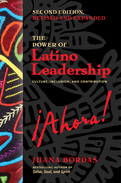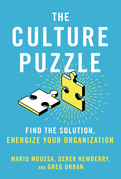Search Results: "how to be an inclusive leader"
Results 49-54 of 663
The times demand a new style of leadership. Employees today are highly trained and independent-they can offer much more to an enterprise than simply their obedience. And with the relationship between worker and organization constantly changing, no one person will likely be able to lead alone. Creating Leaderful Organizations presents a paradigm of leadership tailored to our times, one that is based on mutual-rather than heroic-leadership.
It is not merely consultative, with leaders graciously allowing followers to participate in leadership, nor is it a stewardship approach in which the leader occasionally steps aside to allow others to take over temporarily. It is a revolutionary new approach that transforms leadership from an individual property to a collective responsibility. Raelin details how "leaderful" practice can accomplish the critical processes of leadership more effectively than any existing approach. And using actual examples from leading-edge organizations, he offers practical guidance for assessing your own and others' leaderful predisposition, preparing for leaderful practice, distributing leadership roles, and dealing with resistance to change.
- Outlines a revolutionary new approach to leadership that is better able to respond to organizational turbulence, meet customer expectations, maintain employee commitment, and unleash creativity
- Shows why leadership must be concurrent-with two or more people leading simultaneously-if organizations are to flourish
- Includes examples of this new approach in action from some of today's most progressive organizations -- the Peace Corps, Orpheus Chamber Orchestra, Virgin, Harley-Davidson, and The New Yorker.
Lift
2015
NEW EDITION, REVISED AND UPDATED
Harness the Science of Positive Influence
Just as the Wright Brothers combined science and practice to finally realize the dream of flight, Ryan and Robert Quinn combine research and personal experience to demonstrate how to reach a psychological state that lifts us and those around us to greater heights of achievement, integrity, openness, and empathy. The updated edition of this award-winning book—honored by Utah State University's Huntsman School of Business, Benedictine University, and the LeadershipNow web site --includes two new chapters, one describing a learning process and social media platform the Quinns created to help people experience lift and the other sharing new insights into tapping into human potential.
Harness the Science of Positive Influence
Just as the Wright Brothers combined science and practice to finally realize the dream of flight, Ryan and Robert Quinn combine research and personal experience to demonstrate how to reach a psychological state that lifts us and those around us to greater heights of achievement, integrity, openness, and empathy. The updated edition of this award-winning book—honored by Utah State University's Huntsman School of Business, Benedictine University, and the LeadershipNow web site --includes two new chapters, one describing a learning process and social media platform the Quinns created to help people experience lift and the other sharing new insights into tapping into human potential.
Courage Goes To Work
2019
The hardest part of a manager's job isn't staying organized, meeting deliverable dates, or staying on budget. It's dealing with people who are too comfortable doing things the way they've always been done and too afraid to do things differently—workers who are, as author Bill Treasurer puts it, too “comfeartable.” Such workers fail to exert themselves any more than they have to, equating “just enough” with good enough. By avoiding even mild challenges, these workers thwart forward progress and make their businesses dangerously safe.
To combat this affliction, Treasurer proposes a bold antidote: courage. In Courage Goes to Work, he lays out a comprehensive, step-by-step process that treats courage as a skill that can be developed and strengthened. He Treasurer shows how managers can build workplace courage by modeling courageous behavior themselves, creating an environment where people feel safe taking chances and helping workers deal with fear.
To make the concept of courage more concrete, Treasurer identifies what he calls the Three Buckets of Courage: Try Courage, having the guts to take initiative; Trust Courage, being willing to follow the lead of others; and Tell Courage, being honest and assertive with coworkers and bosses. He illustrates each with a variety of vivid real-world examples and offers proven practices for helping your workers keep each bucket full.
Aristotle said that courage is the first virtue because it makes all other virtues possible. It's as true in business as it is in life. With more courage, workers gain the necessary confidence to take on harder projects, embrace company changes with more enthusiasm, and extend themselves in ways that will benefit their careers and their company. Courage Goes to Work is the first book to take a systematic approach to developing a vital but overlooked component of business success.
To combat this affliction, Treasurer proposes a bold antidote: courage. In Courage Goes to Work, he lays out a comprehensive, step-by-step process that treats courage as a skill that can be developed and strengthened. He Treasurer shows how managers can build workplace courage by modeling courageous behavior themselves, creating an environment where people feel safe taking chances and helping workers deal with fear.
To make the concept of courage more concrete, Treasurer identifies what he calls the Three Buckets of Courage: Try Courage, having the guts to take initiative; Trust Courage, being willing to follow the lead of others; and Tell Courage, being honest and assertive with coworkers and bosses. He illustrates each with a variety of vivid real-world examples and offers proven practices for helping your workers keep each bucket full.
Aristotle said that courage is the first virtue because it makes all other virtues possible. It's as true in business as it is in life. With more courage, workers gain the necessary confidence to take on harder projects, embrace company changes with more enthusiasm, and extend themselves in ways that will benefit their careers and their company. Courage Goes to Work is the first book to take a systematic approach to developing a vital but overlooked component of business success.
Trauma Stewardship
2009
This beloved bestseller—over 180,000 copies sold—has helped caregivers worldwide keep themselves emotionally, psychologically, spiritually, and physically healthy in the face of the sometimes overwhelming traumas they confront every day.
A longtime trauma worker, Laura van Dernoot Lipsky offers a deep and empathetic survey of the often-unrecognized toll taken on those working to make the world a better place. We may feel tired, cynical, or numb or like we can never do enough. These, and other symptoms, affect us individually and collectively, sapping the energy and effectiveness we so desperately need if we are to benefit humankind, other living things, and the planet itself.
In Trauma Stewardship, we are called to meet these challenges in an intentional way. Lipsky offers a variety of simple and profound practices, drawn from modern psychology and a range of spiritual traditions, that enable us to look carefully at our reactions and motivations and discover new sources of energy and renewal. She includes interviews with successful trauma stewards from different walks of life and even uses New Yorker cartoons to illustrate her points.
“We can do meaningful work in a way that works for us and for those we serve,” Lipsky writes. “Taking care of ourselves while taking care of others allows us to contribute to our societies with such impact that we will leave a legacy informed by our deepest wisdom and greatest gifts instead of burdened by our struggles and despair.”
A longtime trauma worker, Laura van Dernoot Lipsky offers a deep and empathetic survey of the often-unrecognized toll taken on those working to make the world a better place. We may feel tired, cynical, or numb or like we can never do enough. These, and other symptoms, affect us individually and collectively, sapping the energy and effectiveness we so desperately need if we are to benefit humankind, other living things, and the planet itself.
In Trauma Stewardship, we are called to meet these challenges in an intentional way. Lipsky offers a variety of simple and profound practices, drawn from modern psychology and a range of spiritual traditions, that enable us to look carefully at our reactions and motivations and discover new sources of energy and renewal. She includes interviews with successful trauma stewards from different walks of life and even uses New Yorker cartoons to illustrate her points.
“We can do meaningful work in a way that works for us and for those we serve,” Lipsky writes. “Taking care of ourselves while taking care of others allows us to contribute to our societies with such impact that we will leave a legacy informed by our deepest wisdom and greatest gifts instead of burdened by our struggles and despair.”
Experience the power of inclusion, community, and taking action! An updated, expanded edition.
By 2045 Latinos will make up 1 in 4 Americans. They are projected to be 78% of the new entries into the labor force in the next ten years. By sheer numbers alone, Latinos will shape the 21st Century. What does it take to lead such a varied and vibrant people who hail from twenty-six countries and are a blend of different races? And what can leaders of all cultures and ethnicities learn from how Latinos lead?
Juana Bordas takes us on a journey to the very heart and soul of Latino leadership. She offers 10 principles that richly illustrate the inclusive, people-centered, socially responsible, and life-affirming ways Latinos have led their community. This model is uniquely suited to this century's multicultural, global age.
This new and expanded edition includes a chapter on intergenerational leadership that recognizes vast generational shifts are occurring: ten thousand Baby Boomers retire every day and Millennials and Zs are the largest generations in history. Six out of 10 Latinos are millennials. This new chapter can guide us in preparing the next generations to take the helm of leadership.
This unprecedented and wide-ranging book shows that Latino leadership is indeed powerful and distinctive and has lessons that can inform leaders of every background.
By 2045 Latinos will make up 1 in 4 Americans. They are projected to be 78% of the new entries into the labor force in the next ten years. By sheer numbers alone, Latinos will shape the 21st Century. What does it take to lead such a varied and vibrant people who hail from twenty-six countries and are a blend of different races? And what can leaders of all cultures and ethnicities learn from how Latinos lead?
Juana Bordas takes us on a journey to the very heart and soul of Latino leadership. She offers 10 principles that richly illustrate the inclusive, people-centered, socially responsible, and life-affirming ways Latinos have led their community. This model is uniquely suited to this century's multicultural, global age.
This new and expanded edition includes a chapter on intergenerational leadership that recognizes vast generational shifts are occurring: ten thousand Baby Boomers retire every day and Millennials and Zs are the largest generations in history. Six out of 10 Latinos are millennials. This new chapter can guide us in preparing the next generations to take the helm of leadership.
This unprecedented and wide-ranging book shows that Latino leadership is indeed powerful and distinctive and has lessons that can inform leaders of every background.
The Culture Puzzle
2021
Corporate culture is critical to any organizational change effort. This book offers a proven model for identifying and leveraging the essential elements of any culture.
In a world that changes at a dizzying pace, what can leaders do to build flexible and adaptive workplaces that inspire people to achieve extraordinary results? According to the authors, the answer lies in recognizing and aligning the elusive forces—or the “puzzling” pieces—that shape an organization's culture.
With a combined seventy-five years' worth of research, teaching, and consulting experience, Mario Moussa, Derek Newberry, and Greg Urban bring a wealth of knowledge to creating nimble organizations. Globally recognized business anthropologists and management experts, they explain how to access the full power of your culture by harnessing the Four Forces that drive it:
Vision: Embrace a common purpose that illuminates shared aspirations and plans.
Interest: Foster a deep commitment to authentic relationships and your organization's future.
Habit: Establish routines and rituals that reinforce “the way we do things around here.”
Innovation: Promote the constant tinkering that produces surprising new solutions to old problems.
Filled with case studies, personal anecdotes, and solid, practical advice, this book includes a four-part Evaluator to help you build resilient organizations and teams. The Culture Puzzle offers the definitive playbook for thriving amid constant transformation.
In a world that changes at a dizzying pace, what can leaders do to build flexible and adaptive workplaces that inspire people to achieve extraordinary results? According to the authors, the answer lies in recognizing and aligning the elusive forces—or the “puzzling” pieces—that shape an organization's culture.
With a combined seventy-five years' worth of research, teaching, and consulting experience, Mario Moussa, Derek Newberry, and Greg Urban bring a wealth of knowledge to creating nimble organizations. Globally recognized business anthropologists and management experts, they explain how to access the full power of your culture by harnessing the Four Forces that drive it:
Vision: Embrace a common purpose that illuminates shared aspirations and plans.
Interest: Foster a deep commitment to authentic relationships and your organization's future.
Habit: Establish routines and rituals that reinforce “the way we do things around here.”
Innovation: Promote the constant tinkering that produces surprising new solutions to old problems.
Filled with case studies, personal anecdotes, and solid, practical advice, this book includes a four-part Evaluator to help you build resilient organizations and teams. The Culture Puzzle offers the definitive playbook for thriving amid constant transformation.


